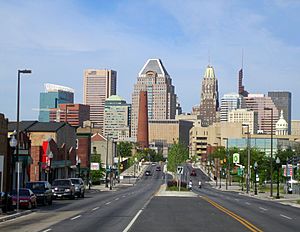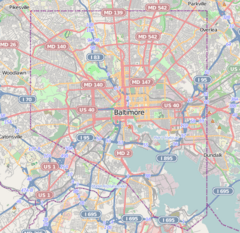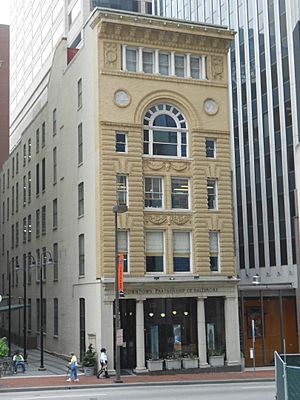Downtown Baltimore facts for kids
Quick facts for kids
Downtown Baltimore
City Centre
|
|
|---|---|
|
Central Business District
and residential area |
|

Downtown Baltimore as seen from East Fayette Street
|
|
| Country | United States |
| State | Maryland |
| City | Baltimore |
| Population | 4,448 |
Downtown Baltimore is the busy heart of Baltimore, a big city in Maryland, United States. It's where many businesses are located, like a central hub for the city. It's also a growing neighborhood where lots of people live.
This area is generally found between Martin Luther King, Jr. Boulevard on the west and President Street on the east. To the north is Franklin Street, and to the south is the famous Inner Harbor.
In 1904, a huge fire almost destroyed Downtown Baltimore. It caused about $150 million in damage. Even so, Downtown Baltimore has been the main business center for the Baltimore metropolitan area since the city was officially started in 1796. Today, over 37,000 people call Downtown Baltimore home. Many new apartment buildings are being built there.
Exploring Downtown Baltimore
Downtown Baltimore is a lively place with lots to see and do. It's known for its tall buildings and fun attractions.
Tall Buildings and Business Hubs
Downtown Baltimore is home to most of the city's skyscrapers. You can see impressive buildings like the Bank of America building and the Transamerica Tower. The Baltimore World Trade Center is also here.
The area includes historic Charles Street, which is important for shopping and culture. Other busy streets are Pratt Street (running east to west) and St. Paul Street-Calvert Street (running north to south).
The Inner Harbor: Fun for Everyone
The Inner Harbor is a top spot for tourists and locals. It has many restaurants, hotels, and shops like Harborplace. You can also find entertainment at places like Power Plant Live!.
National Geographic magazine even called the Inner Harbor one of the best summer trips in 2012. It's a great place to visit!
Museums and Learning Centers
The Inner Harbor is packed with cool museums and science places. You can explore the Maryland Science Center or see amazing sea creatures at the National Aquarium in Baltimore.
Other great spots include the Reginald F. Lewis Museum of Maryland African American History & Culture and the Flag House & Star-Spangled Banner Museum. Kids will love Port Discovery children's museum. There are also Living Classroom centers for environmental learning.
Many old industrial buildings from the 1700s and 1800s have been given new life here. For example, the Pratt Street Power Plant, built in 1900, now has a Barnes & Noble bookstore and the Baltimore Hard Rock Cafe.
Westside Baltimore: History and New Ideas
Westside Baltimore is the western part of downtown. It has many new buildings and the Baltimore Convention Center. This area used to be famous for its big department stores.
Today, the University of Maryland, Baltimore is a major part of the Westside. It includes the University of Maryland Health System and the University of Maryland School of Law.
Arts and Culture on the Westside
The Westside is also a hub for performing arts. You can catch a show at the Hippodrome Theatre or the Everyman Theatre. The Royal Farms Arena hosts big events and concerts.
You can also visit G. Krug & Son Ironworks and Museum. It's the oldest blacksmith shop in the United States that's still running in its original spot!
Literary and Market History
The former home of famous American writer Edgar Allan Poe is nearby. You can visit the Edgar Allan Poe House and Museum. His grave is also just a few blocks away.
Close by is the historic Lexington Market. This market started in 1782 and has been open ever since. It's one of the oldest running markets in the world, selling all kinds of food.
Mount Vernon: Culture and Nightlife
Mount Vernon is just north of Downtown. It's known as the cultural district. This area has a lively nightlife with many bars and clubs.
You'll see beautiful old townhomes here, many of which are now apartments. Mount Vernon is home to the Joseph Meyerhoff Symphony Hall, where the Baltimore Symphony Orchestra plays. The Lyric Opera House is also here.
The world-famous Peabody Institute is in Mount Vernon, next to the Walters Art Museum. At the very north end is Penn Station. From here, you can take Amtrak trains to other major U.S. cities or MARC trains to Washington, D.C..
Historic Architecture
Cathedral Street is a main road in Mount Vernon. It's named after the National Shrine of the Assumption. This was the first Catholic cathedral built in the United States. It was designed by Benjamin Henry Latrobe, who is called the "father of American architecture." He also designed parts of the U.S. Capitol.
Sports in Downtown Baltimore
Downtown Baltimore is a great place for sports fans! It includes Camden Yards. This area has two major stadiums:
- Oriole Park at Camden Yards: Home of the Baltimore Orioles baseball team.
- M&T Bank Stadium: Home of the Baltimore Ravens football team.
Nearby, you can visit the Sports Legends Museum at Camden Yards. There's also the Babe Ruth Birthplace and Museum, celebrating the famous baseball player.
Getting Around Downtown Baltimore
Downtown Baltimore has many ways to get around. You can use the subway, light rail, or bus service.
For longer trips, Amtrak and MARC Train services are available. You can catch these trains at Penn Station and Camden Station. The area is also easy to reach by car, with access to major highways like I-83, I-95, and I-395.



